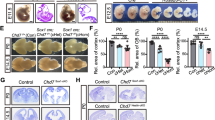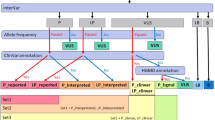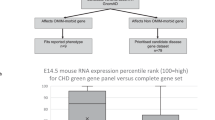Abstract
The Verloes or Hale diagnostic criteria have been applied for diagnosing CHARGE syndrome in suspected patients. This study was conducted to evaluate the diagnostic rate of CHD7 according to these diagnostic criteria in suspected patients and also to investigate other genetic defects in CHD7-negative patients. The clinical findings and the results of genetic testing of CHD7, chromosome microarray, exome sequencing, or genome sequencing of 59 subjects were reviewed. CHD7 pathogenic variants were identified in 78% of 46 subjects who met either the Verloes or Hale diagnostic criteria and in 87% of 38 subjects who met both criteria, whereas no CHD7 variant was detected in 13 subjects who met neither criterion. Among 23 patients without the CHD7 variant, six genetic diseases were identified in 7 patients, including Wolf–Hirschhorn syndrome, 1q21 deletion syndrome, 19q13 microdeletion, and pathogenic variants in PLCB4, TRRAP, and OTX2. Based on these comprehensive analyses, the overall diagnostic rate was 73% for seven different genetic diseases. This study emphasizes the importance of comprehensive clinical and genetic evaluation in patients with clinically suspected CHARGE syndrome, recognizing the overlapping phenotypes in other rare genetic disorders.
This is a preview of subscription content, access via your institution
Access options
Subscribe to this journal
Receive 12 print issues and online access
$259.00 per year
only $21.58 per issue
Buy this article
- Purchase on SpringerLink
- Instant access to full article PDF
Prices may be subject to local taxes which are calculated during checkout


Similar content being viewed by others
Data availability
The data that support the findings of this study can be obtained from the corresponding author upon reasonable request.
References
Pagon RA, Graham JM, Jr, Zonana J, Yong S-L. Coloboma, congenital heart disease, and choanal atresia with multiple anomalies: CHARGE association. J Pediatr. 1981;99:223–7.
Vissers LE, van Ravenswaaij CM, Admiraal R, Hurst JA, de Vries BB, Janssen IM, et al. Mutations in a new member of the chromodomain gene family cause CHARGE syndrome. Nat Genet. 2004;36:955–7.
Sanlaville D, Verloes A. CHARGE syndrome: an update. Eur J Hum Genet. 2007;15:389–99.
Blake KD, Davenport SL, Hall BD, Hefner MA, Pagon RA, Williams MS, et al. CHARGE association: an update and review for the primary pediatrician. Clin Pediatr. 1998;37:159–73.
Verloes A. Updated diagnostic criteria for CHARGE syndrome: a proposal. Wiley Online Libr. 2005;133A:306–8.
Hale CL, Niederriter AN, Green GE, Martin DM. Atypical phenotypes associated with pathogenic CHD7 variants and a proposal for broadening CHARGE syndrome clinical diagnostic criteria. Am J Med Genet Part A. 2016;170:344–54.
Lalani SR, Safiullah AM, Fernbach SD, Harutyunyan KG, Thaller C, Peterson LE, et al. Spectrum of CHD7 mutations in 110 individuals with CHARGE syndrome and genotype-phenotype correlation. Am J Hum Genet. 2006;78:303–14.
Zentner GE, Layman WS, Martin DM, Scacheri PC. Molecular and phenotypic aspects of CHD7 mutation in CHARGE syndrome. Am J Med Genet Part A. 2010;152:674–86.
Bosman EA, Penn AC, Ambrose JC, Kettleborough R, Stemple DL, Steel KP. Multiple mutations in mouse Chd7 provide models for CHARGE syndrome. Hum Mol Genet. 2005;14:3463–76.
Bajpai R, Chen DA, Rada-Iglesias A, Zhang J, Xiong Y, Helms J, et al. CHD7 cooperates with PBAF to control multipotent neural crest formation. Nature. 2010;463:958–62.
Lalani S, Safiullah A, Molinari L, Fernbach S, Martin D, Belmont J. SEMA3E mutation in a patient with CHARGE syndrome. J Med Genet. 2004;94:e94–e94. 41
Oh W-J, Gu C. The role and mechanism-of-action of Sema3E and Plexin-D1 in vascular and neural development. Elsevier. 2013;24:156–62.
Corsten-Janssen N, Saitta SC, Hoefsloot LH, McDonald-McGinn DM, Driscoll DA, Derks R, et al. More clinical overlap between 22q11. 2 deletion syndrome and CHARGE syndrome than often anticipated. Mol Syndromol. 2013;4:235–45.
Schulz Y, Freese L, Mänz J, Zoll B, Völter C, Brockmann K, et al. CHARGE and Kabuki syndromes: a phenotypic and molecular link. Hum Mol Genet. 2014;23:4396–405.
Moccia A, Srivastava A, Skidmore JM, Bernat JA, Wheeler M, Chong JX, et al. Genetic analysis of CHARGE syndrome identifies overlapping molecular biology. Genet Med. 2018;20:1022–9.
Deng H, Zhang Y, Xiao H, Yao Y, Liu X, Su B, et al. Diverse phenotypes in children with PAX2‐related disorder. Mol Genet Genom Med. 2019;7:e701.
Luquetti DV, Hing AV, Rieder MJ, Nickerson DA, Turner EH, Smith J, et al. “Mandibulofacial dysostosis with microcephaly” caused by EFTUD2 mutations: expanding the phenotype. Am J Med Genet Part A. 2013;161:108–13.
Engelen E, Akinci U, Bryne JC, Hou J, Gontan C, Moen M, et al. Sox2 cooperates with Chd7 to regulate genes that are mutated in human syndromes. Nat Genet. 2011;43:607–11.
Krumm N, Sudmant PH, Ko A, O'roak BJ, Malig M, Coe BP, et al. Copy number variation detection and genotyping from exome sequence data. Genome Res. 2012;22:1525–32.
Richards S, Aziz N, Bale S, Bick D, Das S, Gastier-Foster J, et al. Standards and guidelines for the interpretation of sequence variants: a joint consensus recommendation of the American College of Medical Genetics and Genomics and the Association for Molecular Pathology. Genet Med. 2015;17:405–23.
Asakura Y, Toyota Y, Muroya K, Kurosawa K, Fujita K, Aida N, et al. Endocrine and radiological studies in patients with molecularly confirmed CHARGE syndrome. J Clin Endocrinol Metab. 2008;93:920–4.
Sohn YB, Ko JM, Shin CH, Yang SW, Chae J-H, Lee K-A. Cerebellar vermis hypoplasia in CHARGE syndrome: clinical and molecular characterization of 18 unrelated Korean patients. J Hum Genet. 2016;61:235–9.
Thomas AT, Waite J, Williams CA, Kirk J, Oliver C, Richards C. Phenotypic characteristics and variability in CHARGE syndrome: a PRISMA compliant systematic review and meta-analysis. J Neurodev Disord. 2022;14:49.
Castillo A, Kramer N, Schwartz CE, Miles JH, DuPont BR, Rosenfeld JA, et al. 19q13. 32 microdeletion syndrome: three new cases. Eur J Med Genet. 2014;57:654–8.
Shelby E-S, Morris M, Pădure L, Mirea A, Cocoș R, Cărămizaru A, et al. Expanding the clinical phenotype of 19q interstitial deletions: a new case with 19q13. 32-q13. 33 deletion and short review of the literature. Genes. 2022;13:212.
Travan L, Naviglio S, De Cunto A, Pellegrin A, Pecile V, Spinelli AM, et al. Phenotypic expression of 19q13. 32 microdeletions: Report of a new patient and review of the literature. Am J Med Genet Part A. 2017;173:1970–4.
Ragge NK, Brown AG, Poloschek CM, Lorenz B, Henderson RA, Clarke MP, et al. Heterozygous mutations of OTX2 cause severe ocular malformations. Am J Hum Genet. 2005;76:1008–22.
Harvey AS, Leaper PM, Bankier A. CHARGE association: clinical manifestations and developmental outcome. Am J Med Genet. 1991;39:48–55.
Tellier AL, Cormier-Daire V, Abadie V, Amiel J, Sigaudy S, Bonnet D, et al. CHARGE syndrome: report of 47 cases and review. Am J Med Genet. 1998;76:402–9.
Pinto G, Abadie V, Mesnage R, Blustajn J, Cabrol S, Amiel J, et al. CHARGE syndrome includes hypogonadotropic hypogonadism and abnormal olfactory bulb development. J Clin Endocrinol Metab. 2005;90:5621–6.
Issekutz KA, Graham JM Jr, Prasad C, Smith IM, Blake KD. An epidemiological analysis of CHARGE syndrome: preliminary results from a Canadian study. Am J Med Genet Part A. 2005;133:309–17.
Schilter KF, Schneider A, Bardakjian T, Soucy JF, Tyler RC, Reis LM, et al. OTX2 microphthalmia syndrome: four novel mutations and delineation of a phenotype. Clin Genet. 2011;79:158–68.
Gregory LC, Gergics P, Nakaguma M, Bando H, Patti G, McCabe MJ, et al. The phenotypic spectrum associated with OTX2 mutations in humans. Eur J Endocrinol. 2021;185:121–35.
Basson MA. Epistatic interactions between Chd7 and Fgf8 during cerebellar development: Implications for CHARGE syndrome. Rare Dis. 2014;2:28688.
Jiang X, Zhou Y, Xian L, Chen W, Wu H, Gao X. The mutation in Chd7 causes misexpression of Bmp4 and developmental defects in telencephalic midline. Am J Pathol. 2012;181:626–41.
Hever A, Williamson K, Van Heyningen V. Developmental malformations of the eye: the role of PAX6, SOX2 and OTX2. Clin Genet. 2006;69:459–70.
Harding P, Moosajee M. The molecular basis of human anophthalmia and microphthalmia. J Dev Biol. 2019;7:16.
George A, Cogliati T, Brooks BP. Genetics of syndromic ocular coloboma: CHARGE and COACH syndromes. Exp Eye Res. 2020;193:107940.
Hirschhorn K, Cooper HL, Firschein IL. Deletion of short arms of chromosome 4–5 in a child with defects of midline fusion. Humangenetik. 1965;1:479–82.
Bailey R. Wolf–hirschhorn syndrome: a case study and disease overview. Adv Neonatal Care. 2014;14:318–21.
Zollino M, Di Stefano C, Zampino G, Mastroiacovo P, Wright TJ, Sorge G, et al. Genotype–phenotype correlations and clinical diagnostic criteria in Wolf–Hirschhorn syndrome. Am J Med Genet. 2000;94:254–61.
Nevado J, Ho KS, Zollino M, Blanco R, Cobaleda C, Golzio C, et al. International meeting on Wolf–Hirschhorn syndrome: Update on the nosology and new insights on the pathogenic mechanisms for seizures and growth delay. Am J Med Genet Part A. 2020;182:257–67.
Sawan C, Hernandez-Vargas H, Murr R, Lopez F, Vaissière T, Ghantous AY, et al. Histone acetyltransferase cofactor Trrap maintains self-renewal and restricts differentiation of embryonic stem cells. Stem Cells. 2013;31:979–91.
Rauch A, Wieczorek D, Graf E, Wieland T, Endele S, Schwarzmayr T, et al. Range of genetic mutations associated with severe non-syndromic sporadic intellectual disability: an exome sequencing study. Lancet. 2012;380:1674–82.
Xu B, Ionita-Laza I, Roos JL, Boone B, Woodrick S, Sun Y, et al. De novo gene mutations highlight patterns of genetic and neural complexity in schizophrenia. Nat Genet. 2012;44:1365–9.
Cogné B, Ehresmann S, Beauregard-Lacroix E, Rousseau J, Besnard T, Garcia T, et al. Missense variants in the histone acetyltransferase complex component gene TRRAP cause autism and syndromic intellectual disability. Am J Hum Genet. 2019;104:530–41.
Acknowledgements
Conception or design: DK and BHL. Acquisition, analysis, or interpretation of data: DK, JHY, HB, SH, GHS, JYK, YSJ, HSD, SK, IHC, GHK, JHK, JHC, and BHL. Drafting or revising the work: DK and BHL. Final approval of the manuscript: DK, JHY, HB, SH, GHS, JYK, YSJ, HSD, SK, IHC, GHK, JHK, JHC, and BHL.
Funding
This research was supported by a grant of the Research Program funded by the Korea Disease Control and Prevention Agency, Republic of Korea (2021-ER0402-00), the Asan Institute for Life Sciences (Seoul, Republic of Korea) (2024IP0076), 3Billions Inc. (Seoul, Republic of Korea), and Inocras Inc. (Daejeon, Republic of Korea).
Author information
Authors and Affiliations
Corresponding author
Ethics declarations
Competing interests
The authors declare no competing interest.
Additional information
Publisher’s note Springer Nature remains neutral with regard to jurisdictional claims in published maps and institutional affiliations.
Rights and permissions
Springer Nature or its licensor (e.g. a society or other partner) holds exclusive rights to this article under a publishing agreement with the author(s) or other rightsholder(s); author self-archiving of the accepted manuscript version of this article is solely governed by the terms of such publishing agreement and applicable law.
About this article
Cite this article
Kim, D., Yoon, JH., Bae, H. et al. Beyond CHD7 gene: unveiling genetic diversity in clinically suspected CHARGE syndrome. J Hum Genet 70, 243–248 (2025). https://doi.org/10.1038/s10038-025-01325-1
Received:
Revised:
Accepted:
Published:
Issue date:
DOI: https://doi.org/10.1038/s10038-025-01325-1
This article is cited by
-
Novel biallelic CDK9 variants are associated with retinal dystrophy without CHARGE-like malformation syndrome
Journal of Human Genetics (2025)



